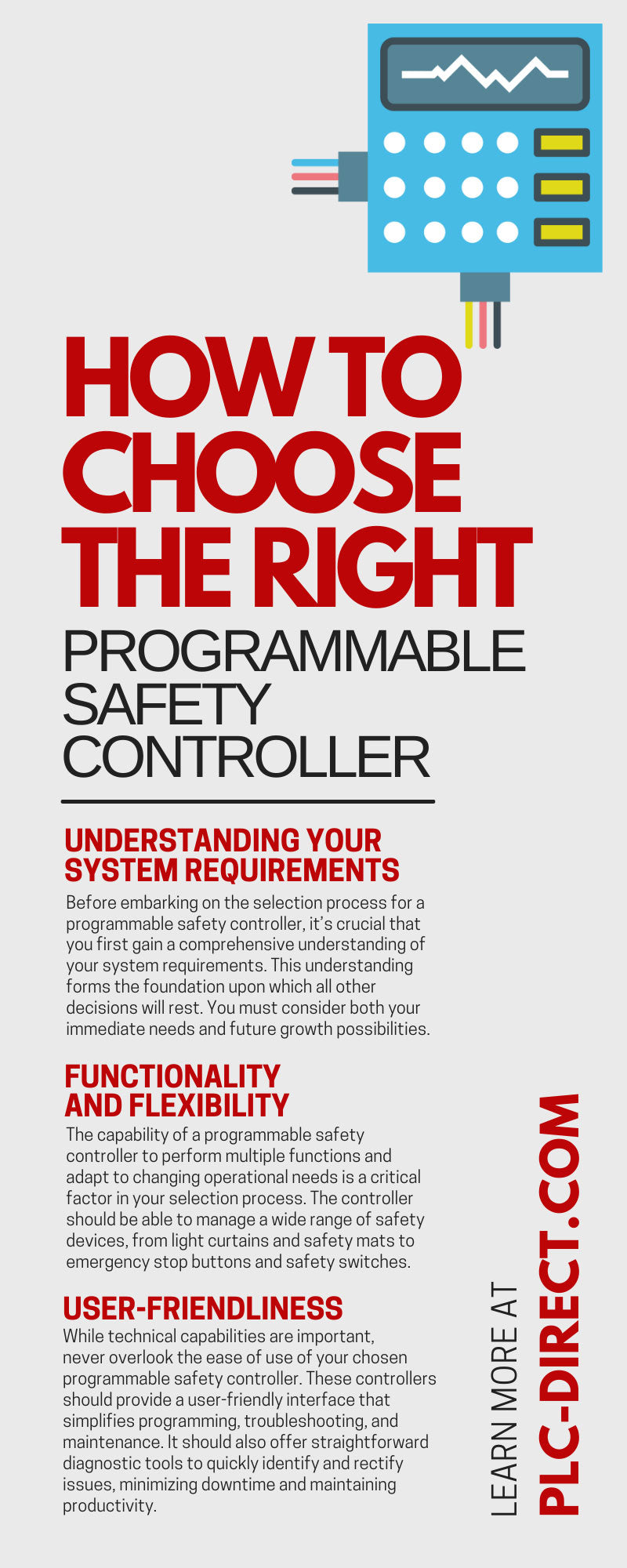Safety is paramount in the world of industrial automation. The heart of this safety lies in the programmable safety controller, a critical component that ensures the smooth operation of machinery while prioritizing operator safety. With one of these tools in your arsenal, you can rest assured that all your processes will follow the safest possible methodologies. Making the right choice when selecting a programmable safety controller is not just an investment in your machinery; it is a commitment to the safety and efficiency of your operations. Here, we’ll tell you how to choose the right programmable safety controller, as well as guide you through the key aspects to consider.
Understanding Your System Requirements
Before embarking on the selection process for a programmable safety controller, it’s crucial that you first gain a comprehensive understanding of your system requirements. This understanding forms the foundation upon which all other decisions will rest. You must consider both your immediate needs and future growth possibilities.
Evaluate the size of your machinery, the complexity of your operations, and the potential for future expansion. A thorough assessment will provide clarity about the type of controller that can best meet your needs. This could be anything from a standalone controller to a more complex system capable of managing several interconnected machines.
Functionality and Flexibility
The capability of a programmable safety controller to perform multiple functions and adapt to changing operational needs is a critical factor in your selection process. The controller should be able to manage a wide range of safety devices, from light curtains and safety mats to emergency stop buttons and safety switches.
Additionally, the controller should have the flexibility to adapt to changes in your operational environment. As your business evolves, your safety controller should accommodate new machinery, increased production lines, or expanded operational processes without necessitating a complete system overhaul.
User-Friendliness
While technical capabilities are important, never overlook the ease of use of your chosen programmable safety controller. These controllers should provide a user-friendly interface that simplifies programming, troubleshooting, and maintenance. It should also offer straightforward diagnostic tools to quickly identify and rectify issues, minimizing downtime and maintaining productivity.
Moreover, it should allow for easy configuration changes to accommodate evolving safety requirements. A controller that is difficult to use can lead to errors and inefficiencies, impacting both safety and productivity. Therefore, user-friendliness is a key consideration when selecting a programmable safety controller.
Scalability
In a rapidly evolving industrial landscape, there’s a strong need for scalability in your programmable safety controller. An ideal controller should meet your current needs and possess the capacity to accommodate future growth and changes in your operations. This means it should have sufficient inputs and outputs and the capability to manage additional safety devices as your machinery expands or upgrades.
Additionally, make sure your device can handle increased data processing demands that come with larger and more complex operations. A scalable controller is a smart investment, providing flexibility that allows your business to grow and adapt without the need for frequent hardware replacements or costly system overhauls.
Compliance with Safety Standards
Another vital thing to assess when choosing the right programmable safety controller for your facility is how well it adheres to industry safety requirements. International safety standards exist to ensure all equipment performs in a way that maximizes a team’s well-being in the workplace. The controller should comply with relevant standards that set out the safety requirements for the design and integration of safety-related parts of control systems.
These standards ensure the highest level of safety and quality, reducing the risk of accidents and protecting your business from potential legal liabilities. It’s essential to verify a controller's compliance with these standards before making a purchasing decision. In addition, the controller should provide features that enable you to demonstrate this compliance easily, such as built-in diagnostic and reporting tools.
Vendor Support and Training
You should also never underestimate the value of robust vendor support and training services during your search. A vendor that offers comprehensive technical support can assist you in resolving issues quickly, minimizing downtime, and ensuring the smooth operation of your machinery.
Vendor-provided training can equip your team with the necessary skills to program, operate, and maintain the controller effectively. This enhances the functionality and longevity of your controller and empowers your team to proactively manage safety in your operations. Therefore, when selecting a controller, consider not just the product itself but also the quality of support and training services offered by the vendor.
Cost Considerations
Above all, take your financial situation into account. Look beyond the initial purchase price and consider the total cost of ownership. This includes not only the upfront expenditure but also ongoing costs such as maintenance, upgrades, and potential downtime due to system failures.
A low-cost controller may seem attractive at first glance, but if it lacks the necessary features, scalability, or robustness, it could lead to higher costs in the long run. For instance, a controller that is not user-friendly may require additional time and resources for programming and troubleshooting, impacting your operational efficiency.
Conversely, an expensive controller with advanced features may provide better value if those features translate into increased productivity, reduced downtime, and enhanced safety. What's more, a controller that complies with international safety standards can save you from potential legal liabilities and reputational damage that could result from safety incidents. Therefore, when evaluating cost, it is crucial to assess the return on investment that the controller can offer over its lifetime.
Selecting the right programmable safety controller is a decision that carries far-reaching implications for your operations. It requires a thorough understanding of your unique business needs as well as how the right features could help your company grow in the future. PLC Direct offers a wide range of automation devices. Our selection of Omron safety PLCs are especially popular for their customizability and ease of use. Remember that the goal is not merely to find the cheapest or most advanced controller but to select a solution that best aligns with your operational needs and offers the greatest value over its lifetime. By making an informed decision, you can ensure the safety and efficiency of your operations, fostering a productive and secure working environment.


